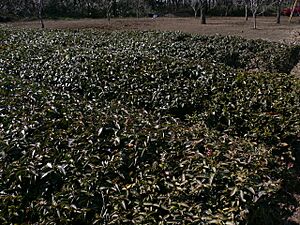Sayama tea facts for kids
Sayama tea (狭山茶, Sayama-cha) is a special kind of green tea. It grows mostly in the southwestern part of Saitama Prefecture and a small area nearby in northwestern Tokyo, Japan. What makes Sayama tea unique is its thick leaves. This is because the area where it grows is quite far north. The cool weather, which sometimes brings frost in winter, means the tea plants need thick leaves to stay healthy and survive.
Contents
What Makes Sayama Tea Special?
For many years, people have worked to grow tea plants that can handle cold weather. They did this by carefully choosing and breeding the strongest plants. Because of this, Sayama tea plants now have thick leaves that can stand up to the cold. Tea made from these thick leaves has a very distinct sweet and rich taste. Sayama tea also has a lot of healthy things called antioxidants, which are good for your body.
Where Does Sayama Tea Grow?
Sayama tea grows on a place called the Musashino Plateau. This area is perfect for growing tea. The plateau has two main layers of soil. The bottom layer is made of rocks and sand brought by old rivers. The top layer is a reddish soil called loam, which formed from volcanic ash. These two layers together make the soil great for tea plants. Tea needs a lot of rain and soil that lets water drain easily, and this region has both.
The History of Sayama Tea
People in Japan started growing tea plants about 800 years ago. This happened when Buddhist monks traveled to China and brought tea seeds back home. An old book from the Nanboku-chō period called Iseiteikin’ōrai (異制庭訓往来) mentioned that Musashi no kawagoe (武蔵河越) was one of the best places for tea. This was alongside other famous tea regions like Yamato, Iga, Ise, Suruga, and Kyoto. However, tea production stopped for a while because of wars during the Sengoku period.
Tea Production Returns
Tea growing became popular again in the middle of the Edo period. In 1802, a new method was invented called Sayama Biire (狭山火入). This method involved first steaming the tea leaves, then roasting them on a special paper called washi. This idea came from a famous roasting method used in Uji, which was considered the best in Japan at the time. Three people, Yoshizumi Yoshikawa (吉川温恭), Morimasa Murano (村野盛政), and Han'emon Sashida (指田半右衛門), developed this technique. It helped tea production in the region grow again. By 1819, Sayama tea made with this method was being sent in large amounts to Edo (which is now Tokyo) and was very popular.
Sayama Tea in Modern Times
After the Meiji Restoration, tea became an important product for Japan to sell to other countries. Sayama tea was even sent to North America. In 1875, a private company called “Sayama Corporation” started selling tea directly to the United States. Around this time, the name "Sayama Tea" became well-known. Even though wars caused tea production to slow down, it quickly recovered. Production reached its highest point in the 1960s and 1970s. Today, however, the amount of Sayama tea grown and the land used for it are about half of what they were in the 1970s.


